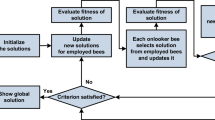Abstract
This paper proposes a new approach for edge detection using a combination of artificial bee colony (ABC) algorithm and an improved derivative technique. ABC algorithm simulates the foraging behavior of a honey bee swarm. The proposed approach find the edge pixels by an improved derivative technique to compute fitness function, and then applying ABC algorithm determine the most fit pixels to be considered as the edge pixels. Qualitative and quantitative analysis of the proposed approach and its comparison with other standard edge detection methods are presented. Shannon’s entropy function and Pratt’s figure of merit are used for quantitative analysis. The effect of variation of parameters on performance of the proposed approach is discussed. Experimental results show that proposed method outperformed most of existing techniques.










Similar content being viewed by others
References
Umbaugh SE (2010) Digital image processing and analysis: human and computer vision applications with CVIPtools, 2nd edn. CRC Press, Boca Raton
Gonzales RC, Woods RE (2002) Digital image processing. Prentice Hall, London
Solomon C, Breckon T (2011) Fundamentals of digital image processing, 1st edn. Wiley-Blackwell, New York
Yu X, Gen M (2010) Introduction to evolutionary algorithms. Springer, Berlin
Yildiz AR (2009) A novel particle swarm optimization approach for product design and manufacturing. Int J Adv Manuf Technol 40:617–628
Yildiz AR (2013) Cuckoo search algorithm for selection of optimal parameters in milling operations. Int J Adv Manuf Technol 64:55–61
Paulinas M, Ušinskas A (2007) A survey of genetic algorithm applications for image enhancement and segmentation. Inf Technol Control 36:278–284
Braik M, Sheta A, Ayesh A (2007) Image enhancement using particle swarm optimization. Proc World Congr Eng 1:696–701
Karkavitsas G, Rangoussi M (2005) Object localization in medical images using genetic algorithms. Int J Inf Commun Eng 1:204–207
Sharma A, Singh N (2010) Object detection in image using particle swarm optimization. Int J Eng Technol 2:419–426
Bhanu B, Lee S, Ming J (1995) Adaptive image segmentation using a genetic algorithm. IEEE Trans Syst Man Cybern 25:1543–1567
Verma OP, Hanmandlu M, Kumar P, Srivastava S (2009) A novel approach for edge detection using ant colony optimization and fuzzy derivative technique. In: Proc IEEE, IACC, pp 1206–1212
Verma OP, Hanmandlu M, Kumar P, Chhabra S, Jindal S (2011) A novel bacterial foraging technique for edge detection. Pattern Recogn Lett 32:1187–1196
Karaboga D (2005) An idea based on honey bee swarm for numerical optimization. Tech Rep TR06, Erciyes University, Engineering Faculty, Computer Engineering Department
Karaboga D, Akay B (2011) A modified artificial bee colony (ABC) algorithm for constrained optimization problems. Appl Soft Comput 11:3021–3031
Karaboga D, Gorkemli B, Ozturk C, Karaboga N (2012) A comprehensive survey: artificial bee colony algorithm and applications, artificial intelligence review. Springer, Berlin
Karaboga D, Okdem S, Ozturk C (2012) Cluster based wireless sensor network routing using artificial bee colony algorithm. Wireless Netw 18:847–860
Ahmad A, Behera AK, Mandal SK, Mahanti GK, Ghatak R (2013) Artificial bee colony algorithm to reduce the side lobe level of uniformly excited linear antenna arrays through optimized element spacing. In: IEEE conference on information and communication technologies (ICT), pp 1029–1032
Zhang Y, Wu L, Wang S (2011) Magnetic resonance brain image classification by an improved artificial bee colony algorithm. Prog Electromagn Res 116:65–79
Zhang Y, Wu L (2012) Artificial bee colony for two dimensional protein folding. Adv Electr Eng Syst 1:19–23
Yildiz AR (2013) A new hybrid bee colony optimization approach for robust optimal design and manufacturing. Appl Soft Comput 13:2906–2912
Yildiz AR (2013) Optimization of cutting parameters in multi-pass turning using artificial bee colony-based approach. Inf Sci 220:399–407
Cuevas E, Echuari FS, Zaldivar D, Cisnero MP (2011) Multi-circle detection on images using artificial bee colony (ABC) optimization. Soft Comput 16:281–296
Ouadfel S, Meshoul S (2012) Handling fuzzy image clustering with a modified ABC algorithm I. J Intell Syst Appl 12:65–74
Sag T, Cunkas M (2012) Development of image segmentation techniques using swarm intelligence, ICCIT, pp 95–100
Karaboga D, Akay B (2009) A comparative study of artificial bee colony algorithm. Appl Math Comput 214:108–132
Haykin S (1994) Communication systems, 2nd edn. Wiley, New York
Pratt W (1978) Digital image processing. Wiley-Interscience, New York
Author information
Authors and Affiliations
Corresponding author
Rights and permissions
About this article
Cite this article
Verma, O.P., Agrawal, N. & Sharma, S. An Optimal Edge Detection Using Modified Artificial Bee Colony Algorithm. Proc. Natl. Acad. Sci., India, Sect. A Phys. Sci. 86, 157–168 (2016). https://doi.org/10.1007/s40010-015-0256-7
Received:
Revised:
Accepted:
Published:
Issue Date:
DOI: https://doi.org/10.1007/s40010-015-0256-7




